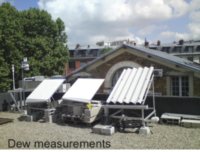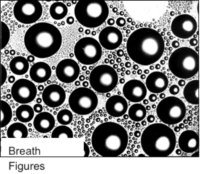Permanent members:
 Condensation from atmospheric water vapour (dew) is currently the subject which we develop. In a context of reduction of clean water sources and growing population, dew can provide from air moisture a new source of water. This phenomenon currently implies many exciting fields in development (radiative and convective heat exchange in the atmosphere, heterogeneous nucleation and self-similar growth, wetting, nano-hydrodynamics, atmospheric chemistry and biology). It also implies natural systems making it possible to benefit from nature and bio-mimetism (dew and fog collecting insects and plants). We have for this purpose on a terrace at ESPCI a continuous measuring site of atmospheric dew for which we have developed a model that gives dew yield in any places of the world where simple meteo data (temperature, relative humidity, windspeed, cloud cover) are collected. (See www.opur.fr ).
Condensation from atmospheric water vapour (dew) is currently the subject which we develop. In a context of reduction of clean water sources and growing population, dew can provide from air moisture a new source of water. This phenomenon currently implies many exciting fields in development (radiative and convective heat exchange in the atmosphere, heterogeneous nucleation and self-similar growth, wetting, nano-hydrodynamics, atmospheric chemistry and biology). It also implies natural systems making it possible to benefit from nature and bio-mimetism (dew and fog collecting insects and plants). We have for this purpose on a terrace at ESPCI a continuous measuring site of atmospheric dew for which we have developed a model that gives dew yield in any places of the world where simple meteo data (temperature, relative humidity, windspeed, cloud cover) are collected. (See www.opur.fr ).
 From the physicist point of view, condensation can occurs filmwise (mainly in industrial condensers cooled by contact) or dropwise, this last situation corresponding rather to natural dew substrates. Here the substrate is cooled by the radiative deficit substrate-atmosphere. This dropwise condensation, called “Breath figures” by Lord Rayleigh, reveals much originality in its growth because the latter is constrained on a surface of dimensionality lower than drop dimensionality. The growth of drops increases the wet surface area; however coalescences decreases it, resulting in average to a constant drop surface coverage and self-similar growth of the breath figure. The drops obey a random movement of non-Brownian nature by the haphazard of coalescence events.
From the physicist point of view, condensation can occurs filmwise (mainly in industrial condensers cooled by contact) or dropwise, this last situation corresponding rather to natural dew substrates. Here the substrate is cooled by the radiative deficit substrate-atmosphere. This dropwise condensation, called “Breath figures” by Lord Rayleigh, reveals much originality in its growth because the latter is constrained on a surface of dimensionality lower than drop dimensionality. The growth of drops increases the wet surface area; however coalescences decreases it, resulting in average to a constant drop surface coverage and self-similar growth of the breath figure. The drops obey a random movement of non-Brownian nature by the haphazard of coalescence events.
Drops slide down due to gravity when their weight compensates for the forces of pinning, which takes place for sizes about a mm. To collect smaller drops, which otherwise would evaporate in the morning, we use a strategy to replace the myriad of tiny drops by a few large drops, which then easily detach. From our observation of condensation in nature, borders of natural substrate (window pane, car windshields, etc.), drops are always larger on the edges than in the middle of the substrate. Drops indeed collect more moisture than in the centre of the substrate where they compete to collect humidity. Growing faster, edge drops detached earlier and wipe the surface droplets as natural wipers. Outputs increased by 400% can be observed due to this effect. Another solution, which can cumulate with the edge effects, is to enhance drop coalescences thanks to microgrooves. Those grooves fill with liquid water by coalescing with and sucking the drops at the superior part. When grooves water overflow, a few very large drops form. Such drops detach all the more quickly that their contact line is reduced and fixed only on the upper part of the grooves.

Condensation can also occur in the form of ice crystals (white frost). This phenomenon is generally preceded by the formation of breath figures of supercooled water drops in a metastable state. We discovered that, according to the drop inter-distance between drops, i.e. according to the value of the drop surface coverage (which depends on the substrate wetting properties), two different processes can occur. An extremely fast phenomenon of percolation can take place between drops or rather a slow growth by evaporation of the supercooled droplets and re-condensation on the ice crystals. These phenomena are used to delay frost formation by using salt crystals. Around the latter we found that, in addition to lowering the melting point of ice, salt keeps dry the substrate around it, a phenomenon due to its vapour tension lower than that of water.


